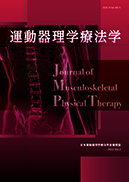Volume 2
Displaying 1-6 of 6 articles from this issue
- |<
- <
- 1
- >
- >|
-
2022Volume 2 Pages 1-12
Published: 2022
Released on J-STAGE: March 20, 2023
Advance online publication: July 08, 2022Download PDF (6357K) -
2022Volume 2 Pages 13-20
Published: 2022
Released on J-STAGE: March 20, 2023
Advance online publication: August 27, 2022Download PDF (1275K) -
2022Volume 2 Pages 21-31
Published: 2022
Released on J-STAGE: March 20, 2023
Advance online publication: October 08, 2022Download PDF (2126K) -
2022Volume 2 Pages 32-40
Published: 2022
Released on J-STAGE: March 20, 2023
Advance online publication: December 23, 2022Download PDF (2369K)
-
2022Volume 2 Pages 41-46
Published: 2022
Released on J-STAGE: March 20, 2023
Advance online publication: September 24, 2022Download PDF (1425K)
-
2022Volume 2 Pages 47-57
Published: 2022
Released on J-STAGE: March 20, 2023
Advance online publication: July 13, 2022Download PDF (2825K)
- |<
- <
- 1
- >
- >|
